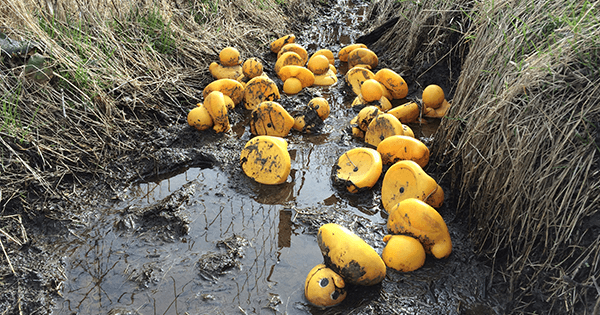
I grew up without ditches. The roads of my childhood were well-paved, with uninterrupted blacktop that stretched between high, rounded curbs and concrete sidewalks in good condition. Sewers whisked away rain and debris, carrying them out of sight.
Most roads around Homer taper off at their edges to gravelly margins and then to ditches. Sidewalks are rare. Ditches fill when it rains, run like creeks in the spring, and collect snow all winter long. They gather life’s refuse and hold it in plain view: beer cans tossed out the window of a moving car, Christmas trees in January, ash from a wood stove dumped by a nearby homeowner. From time to time, city workers come by to ditch the ditches, using heavy machinery to clean them out and dig them deeper.
Ditches are the drainage system we create to keep roads from collapsing into muddy slumps. They transform bogs into grassy lawns and help keep the water that pours endlessly off the bluff away from the foundations of our houses. Part open-air storm drain, part dump, part habitat, and part something else.
I saw that something else when I picked up my three-year-old daughter, Lila, and two of her classmates from preschool not long ago. I gathered the threesome—weighed down in their colorful backpacks and rubber boots—to walk two blocks to where I’d left my car at my older daughter’s school. We crossed the muddy threshold of the preschool yard, which is a piece of netting that serves as a gate in the tall moose fence. Then we ambled down the driveway onto a short dirt road. That was where we made our first stop. Leo spotted a nearly dried-up puddle, the kind of puddle with a perfect sheen of slick mud in it. The kids drew their fingers across it, leaving mysterious messages in its surface. Then, when we turned onto the second unpaved road, we hit the ditch and could go nowhere. It was about three feet deep and five feet wide, with grassy banks. The white vermiculite-specked clump of a houseplant rootball lay in the ditch next to its empty pot. But otherwise the ditch looked pretty clean.
Leo picked a bouquet of horsetail from where they were springing up all along the ditch and handed it to me. Lila announced she was in search of tall grass, and before she could find some herself, Jack brought over a handful. “Tracy says not to pick the dandelions,” Jack said about their teacher, who takes them on long walkabouts around the neighborhood through woods and side yards. Released from that regulation, Lila went straight for a dandelion on the banks of the ditch and tore it out of the ground. Then Jack stepped down into the ditch itself, where a few inches of water ran clear over a bright orange, mucky bottom—stained, I think, by the iron-rich mud we have here. Jack swiped his hand through the water and pulled out a long strand of algae. “Look!” he shouted. They could have stayed at that spot for an hour.
Ditches are margins. And margins are places left to their own devices, which can be bad, of course, as well as good. The other day, Leo’s mom told me he fell in the muddy ditch at the edge of the preschool yard. Perhaps that ditch is a pain in the neck, but where else can a small marvel of engineering be a place of play and wonder, too?

